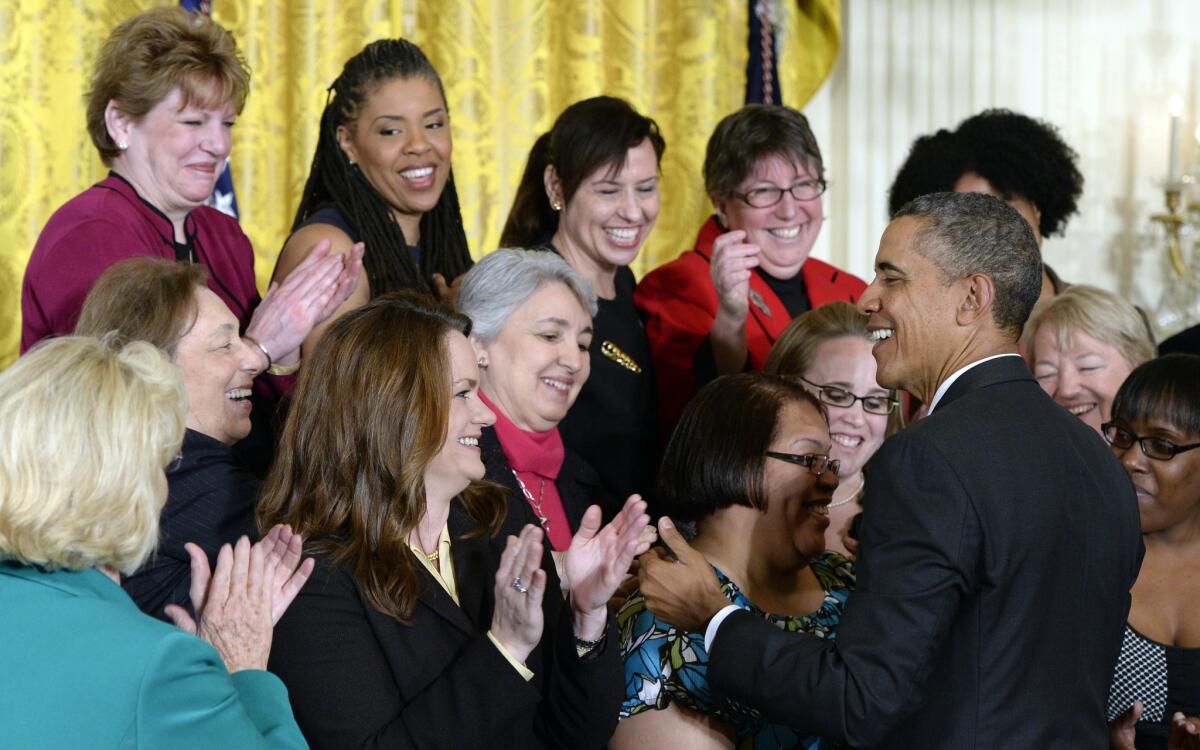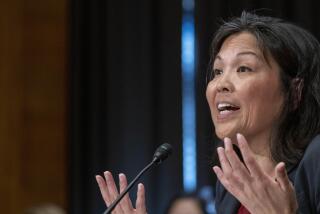Obama moves to close gender wage gap

President Obama greets people in the East Room of the White House during an event marking Equal Pay Day on April 8, 2014.
Reporting from Washington — The first bill President Obama signed after taking office in 2009 was designed to help close the pay gap between men and women.
But saying progress has been slow, Obama announced a new plan Friday to try to ensure that women earn the same as men for doing the same job.
The proposal, which doesn’t need legislative approval, would require businesses with at least 100 employees to submit annual pay data by gender, race and ethnicity in an effort to find firms that the White House said are “unlawfully shortchanging workers.”
The median annual wage for a woman working full time is $39,600, 79% the median wage for a man, the White House said, although some critics said that generalized figure overstates the difference.
The gap has “narrowed slightly” the last two years, but still is too wide, the White House said.
“What kind of example does paying women less set for our sons and daughters?” President Obama said in announcing the new requirements at a White House ceremony Friday celebrating the seventh anniversary of his signing of the Lilly Ledbetter Fair Pay Act. That legislation made it easier for workers to challenge what they view as unfair pay.
The latest federal move comes after California enacted one of the toughest pay equity laws in the nation. The state’s Fair Pay Act, which took effect Jan. 1, broadened federal laws. California employers now aren’t allowed to pay a female employee less than a male employee for “substantially similar work,” even if there are different job titles or work sites.
The new federal rules would help California implement its law by providing pay information that has been unavailable, said state Sen. Hannah-Beth Jackson (D-Santa Barbara), who wrote the Fair Pay Act.
“Companies will have to come forward with that data,” she said. “That’s always been a big problem — what can we show? What can we do to identify where the problems are or that the problems even exist?”
The U.S. Chamber of Commerce criticized the additional federal reporting requirements as too burdensome. The Obama administration plan, expected to be approved by the Equal Employment Opportunity Commission in the coming months after public comment and a hearing, would take effect Sept. 30, 2017.
“While we strongly support nondiscrimination in compensation, the type of reporting proposed by the administration today would place unnecessary and onerous burdens on employers while providing no meaningful insight as to whether employer pay practices are discriminatory,” said Randy Johnson, the chamber’s senior vice president of labor, immigration and employee benefits.
But Eleanor Smeal, president of the Feminist Majority Foundation, said the Obama administration’s action was “a big step forward.”
“An awful lot of times, people will say there is no income gap. There is, and we know there is,” she said. “It is extremely important to have that concrete data by occupation and by region of the country. We have been fighting for that for a long time.”
The Obama administration plan would expand on a 2014 executive order that the Labor Department collect wage data by gender, race and ethnicity from federal contractors.
Now the Equal Employment Opportunity Commission has proposed that all employers with at least 100 workers submit the data across 10 job categories and 12 pay ranges on a form they already are required to submit annually that includes employment data by gender, race and ethnicity.
Specific salaries would not have to be reported and the data would not be made public. The EEOC said it would analyze the information to better focus investigations into unlawful pay practices.
Kristin Michaels, who represents employers in labor litigation, said it was unclear how federal officials would conduct that analysis. She noted that a 2013 report by the National Research Council recommended against using pay ranges and total earnings and suggested measuring compensation based on rates of pay, such as hourly wages.
“The continuing problem is you simply can’t compare either wage rate to wage rate or earnings to earnings because there are other factors that go into compensation decisions,” said Michaels, a partner at the McDermott Will & Emery law firm in Chicago. “It’s education, it’s tenure, it’s potentially additional hours worked when you’re taking about salaried employees.”
“It’s going to potentially give a lot of false positives (for wage discrimination) that employers will have to spend the time to disprove,” she said.
But Noreen Farrell, executive director of Equal Rights Advocates, a San Francisco group that focuses on women’s rights, said the data would make it easier for the government to enforce existing pay laws and also force industries to confront pay discrepancies.
“This is a great step for companies to evaluate themselves,” she said. “Once pay gaps are revealed in black-and-white data, there is an additional incentive for employers to address it.”
Puzzanghera reported from Washington and Li from Los Angeles.
Staff writer Evan Halper contributed to this report.
More to Read
Inside the business of entertainment
The Wide Shot brings you news, analysis and insights on everything from streaming wars to production — and what it all means for the future.
You may occasionally receive promotional content from the Los Angeles Times.












